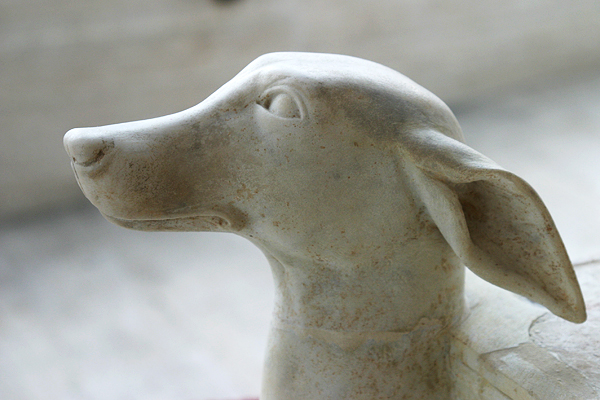
"But do you cast off the leashes from the dogs that hunt in silence; still let thongs hold the keen Molossians fast, and let the savage Cretans tug on the stout bonds with well-worn necks. But the Spartans (for their breed is bold and eager for the prey) hold in carefully with a tighter knot. The time will come when the hollow rocks will re-echo with their bayings; now, with heads low-hung, let them snuff the air with keen nostrils, and with muzzles to earth quest through the forest haunts, while the light is still dim, while the dewy ground still retains the well-marked trail."
Seneca, Phaedra (31ff)
Crouched and ready to dash forward, this Laconian (which is in the Acropolis Museum) may have been one of a pair set up in the precinct of Artemis Brauronia adjacent to the Propylaea on the Acropolis. The shrine was transferred there from the sanctuary at Brauron and is attributed to Peisistratus or his sons. The marble statue dates to about 520 BC and is regarded as an exceptional representation.

"Give names that are short and swiftly spoken that they may hear a command swiftly."
Oppian, Cynegetica (I.444ff; also Columella, VII.13 and Xenophon, VII.5)
This Vertragus is one of four that are placed in the corners of a marble base that presumably supported a decorative bronze. It dates to the early imperial period and was found in the Horti Maecenatiani (Gardens of Maecenas) in 1877.

"So the hunter: until he surrounds the stags...he checks the noisy mouth of the swift Molossian dog and ties his Spartan and his Cretan hounds, entrusting the forest only to the dog which picks up traces with its muzzle on the ground and when the prey is found knows not to bark, content to show the lair with quivering leash."
Lucan, Pharsalia (437ff)
This powerful animal also was discovered in the Horti Maecenatiani and is sculpted of green serpentine marble, which shows an Egyptian influence. Both statues are in the Capitoline Museums (Rome).